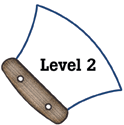
Alaska Science
Key Element A4
A student who meets the content standard should understand observable natural events such as tides, weather, seasons, and moon phases in terms of the structure and motion of the Earth (Earth).
 |
Alaska Science A student who meets the content standard should understand observable natural events such as tides, weather, seasons, and moon phases in terms of the structure and motion of the Earth (Earth). |
|
Performance Standard Level 2, Ages 8–10
|
|
|
|
Sample Assessment Ideas
|
|
|
Expanded Sample Assessment Idea
|
|
Levels of Performance |
||
|
Stage 4 |
The student song or poem accurately describes changing weather patterns using scientific knowledge, data collected during daily weather measurements, and indigenous knowledge or stories. The song or poem and the explanation show detailed evidence of transfer and extension of weather-related knowledge. | ||
|
Stage 3
|
The student song or poem accurately describes changing weather patterns using several examples of scientific knowledge, data collected during daily weather measurements, or indigenous knowledge and stories. The song or poem and the explanation show evidence of transfer and extension of weather-related knowledge, but may contain minor errors or omissions. | ||
|
Stage 2
|
The student song or poem may contain evidence of skilled word-play, but may be incomplete, incorrect, or lack scientific weather detail. Student work shows limited evidence of weather-related knowledge, transfer or extension of this knowledge, and may contain errors of science fact and reasoning. | ||
|
Stage 1
|
The student song or poem and explanation are largely incomplete, incorrect, and show little or no evidence of weather-related knowledge, transfer, or extension of this knowledge. | ||
Standards Cross-References
|
||
|
National Science Education Standards Weather changes from day to day and over the seasons. Weather can be described by measurable quantities, such as temperature, wind direction and speed, and precipitation. (Page 134) Most objects in the sky are in regular and predictable motion. Those motions explain such phenomena as the day, the year, phases of the moon, and eclipses. (Page 160) Gravity is the force that keeps planets in orbit around the sun and governs the rest of the motion in the solar system. Gravity alone holds us to the Earth’s surface and explains the phenomena of the tides. (Page 161) The sun is the major source of energy for phenomena on the Earth’s surface, such as growth of plants, winds, ocean currents, and the water cycle. Seasons result from variations in the amount of the sun’s energy hitting the surface, due to the tilt of the Earth’s rotation on its axis and the length of the day. (Page 161) |
Benchmarks Things on or near the Earth are pulled toward it by the Earth’s gravity. (Page 68) Like all planets and stars, the Earth is approximately spherical in shape. The rotation of the Earth on its axis every 24 hours produces the night-and-day cycle. To people on Earth, this turning of the planet makes it seem as though the sun, moon, planets, and stars are orbiting the Earth once a day. (Page 68) When liquid water disappears, it turns into a gas (vapor) in the air and can reappear as a liquid when cooled, or as a solid if cooled below the freezing point of water. Clouds and fog are made of tiny droplets of water. (Page 68) Air is a substance that surrounds us, takes up space, and whose movement we feel as wind. (Page 68) |
|
Table of Contents | Return to Alaska Native Knowledge Network